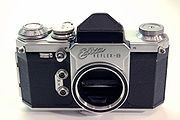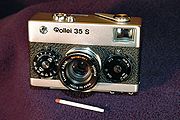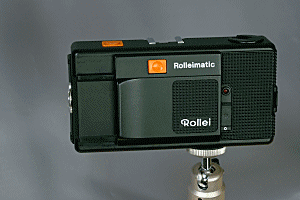
Heinz Waaske
Encyclopedia
Heinz Waaske was a German
camera
designer, notably father of the Rollei 35
.
, Heinz Waaske started his career as a precision mechanic apprentice at Telefunken
in Sickingenstraße in Berlin, where he studied from 1939 to 1942. After serving in the Army during World War II
, being severely wounded and taken prisoner
, he joined Krenzin in Berlin-Kreuzberg. There he encountered camera technology for the first time, and developed a great taste for it. For financial reasons, he could not study engineering. He started designing a 16mm miniature camera in his spare time, and sold the prototype in 1948 for 3.000 Marks
.

 From 1948, Waaske transferred to the Wirgin
From 1948, Waaske transferred to the Wirgin
brothers company in Wiesbaden
. He worked as a precision mechanic and soon rose to head of the prototype workshop, to technical designer, and eventually to chief designer. He first improved the medium format 6x9 cameras, allowing cheaper manufacturing procedures.
By then a chief designer, he decided to design a mirror reflex camera
, which materialised as the Edixa miniature reflex. Wirgin joined the club of the renowned mirror reflex manufacturers. Waaske further designed all the successors to the Edixa, including the Edixamat reflex and the Edixa Electronica.
When he designed the Edixa 16, Waaske had to design the shutter himself, as suppliers could not provide sufficiently small mechanisms. The Edixa 16 was a camera using the 16 mm film cartridges by Rollei, a cheaper alternative to the expensive Rollei cameras.
Waaske had understood that there was a market for small cameras which would use 135 film rather than the ultra-miniature formats. He made the design in his living room and had Wirgin Musterbau manufacture the parts for the prototype. When Waaske showed the prototype to Wirgin Musterbau, he was told "So, you've wasted my time and my equipment for your own projects?" Wirgin then left the camera business and the company closed.
At the time, the only other camera manufacturers were Leitz and Kodak, who had no interest in hiring Waaske.
 Waaske joined Rollei in January 1965, and at first did not mention his attempts for a compact 135 camera. The chief of development, Richard Weiß, had him work on the Rolleiflex SL 26. When Waaske shown his pocket camera prototype to Dr. Heinrich Peesel, the boss of Rollei, the later was so enthusiastic that he had it propared for mass production on the spot. The Rollei 35
Waaske joined Rollei in January 1965, and at first did not mention his attempts for a compact 135 camera. The chief of development, Richard Weiß, had him work on the Rolleiflex SL 26. When Waaske shown his pocket camera prototype to Dr. Heinrich Peesel, the boss of Rollei, the later was so enthusiastic that he had it propared for mass production on the spot. The Rollei 35
was introduced at Photokina
1966 and became instantly an international success.
Later, Waaske introduced improvements in the loading system of small format reflex cameras which were mass-produced with the Rollei Rolleiflex SL2000F.
Waaske's last contribution to Rollei was the Rolleimatic, which was designed to be as easy to use as the Instamatic
camera, but use the 135 format, allowing for a better image quality. Waaske resigned his position at Rollei in 1978, before the introduction of the Rolleimatic on the market, in 1980.
, working not only on cameras but also, for instance, on loudspeaker systems which went into production with Blaupunkt
. His work was characterised by a "technical minimalism", with small and scarse pieces providing as many functions as possible.
Waaske was very inclined towards practical usefulness, and he was very critical of the collection edition of the Rollei 35, with casing made of precious metal. His aim was at providing compact and functional to everybody. He also tartly rejected requests for designing military equipment, arguing that after his experience of the Second World War, he had had enough with war.
He died in 1995 in Braunschweig, and a street of the city was named Heinz Waaske Weg in his honour.

Germany
Germany , officially the Federal Republic of Germany , is a federal parliamentary republic in Europe. The country consists of 16 states while the capital and largest city is Berlin. Germany covers an area of 357,021 km2 and has a largely temperate seasonal climate...
camera
Camera
A camera is a device that records and stores images. These images may be still photographs or moving images such as videos or movies. The term camera comes from the camera obscura , an early mechanism for projecting images...
designer, notably father of the Rollei 35
Rollei 35
The Rollei 35 is a 35mm miniature viewfinder camera built by Rollei. The original Rollei 35, when introduced at Photokina in 1966, was the smallest existing 135 film camera. Still today, the Rollei 35 series remain the second smallest 35 mm camera after the Minox 35...
.
Early career
Born in BerlinBerlin
Berlin is the capital city of Germany and is one of the 16 states of Germany. With a population of 3.45 million people, Berlin is Germany's largest city. It is the second most populous city proper and the seventh most populous urban area in the European Union...
, Heinz Waaske started his career as a precision mechanic apprentice at Telefunken
Telefunken
Telefunken is a German radio and television apparatus company, founded in Berlin in 1903, as a joint venture of Siemens & Halske and the Allgemeine Elektricitäts-Gesellschaft...
in Sickingenstraße in Berlin, where he studied from 1939 to 1942. After serving in the Army during World War II
World War II
World War II, or the Second World War , was a global conflict lasting from 1939 to 1945, involving most of the world's nations—including all of the great powers—eventually forming two opposing military alliances: the Allies and the Axis...
, being severely wounded and taken prisoner
Prisoner of war
A prisoner of war or enemy prisoner of war is a person, whether civilian or combatant, who is held in custody by an enemy power during or immediately after an armed conflict...
, he joined Krenzin in Berlin-Kreuzberg. There he encountered camera technology for the first time, and developed a great taste for it. For financial reasons, he could not study engineering. He started designing a 16mm miniature camera in his spare time, and sold the prototype in 1948 for 3.000 Marks
German mark
The Deutsche Mark |mark]], abbreviated "DM") was the official currency of West Germany and Germany until the adoption of the euro in 2002. It is commonly called the "Deutschmark" in English but not in German. Germans often say "Mark" or "D-Mark"...
.
Work with Wirgin


Wirgin
Wirgin was a German company which is still known for its brands Wirgin and Edixa, and for its camera types like the Edina, the Edinex or the Gewirette. It was based in the Hessian capital Wiesbaden and made a line of quite inexpensive 35mm SLRs from the 1950s to the 1970s, including the Edixa...
brothers company in Wiesbaden
Wiesbaden
Wiesbaden is a city in southwest Germany and the capital of the federal state of Hesse. It has about 275,400 inhabitants, plus approximately 10,000 United States citizens...
. He worked as a precision mechanic and soon rose to head of the prototype workshop, to technical designer, and eventually to chief designer. He first improved the medium format 6x9 cameras, allowing cheaper manufacturing procedures.
By then a chief designer, he decided to design a mirror reflex camera
Reflex camera
Reflex camera may refer to:*Single-lens reflex camera**Digital single-lens reflex cameras*Twin-lens reflex camera...
, which materialised as the Edixa miniature reflex. Wirgin joined the club of the renowned mirror reflex manufacturers. Waaske further designed all the successors to the Edixa, including the Edixamat reflex and the Edixa Electronica.
When he designed the Edixa 16, Waaske had to design the shutter himself, as suppliers could not provide sufficiently small mechanisms. The Edixa 16 was a camera using the 16 mm film cartridges by Rollei, a cheaper alternative to the expensive Rollei cameras.
Waaske had understood that there was a market for small cameras which would use 135 film rather than the ultra-miniature formats. He made the design in his living room and had Wirgin Musterbau manufacture the parts for the prototype. When Waaske showed the prototype to Wirgin Musterbau, he was told "So, you've wasted my time and my equipment for your own projects?" Wirgin then left the camera business and the company closed.
At the time, the only other camera manufacturers were Leitz and Kodak, who had no interest in hiring Waaske.
Career with Rollei

Rollei 35
The Rollei 35 is a 35mm miniature viewfinder camera built by Rollei. The original Rollei 35, when introduced at Photokina in 1966, was the smallest existing 135 film camera. Still today, the Rollei 35 series remain the second smallest 35 mm camera after the Minox 35...
was introduced at Photokina
Photokina
The photokina is the world's largest trade fair for the photographic and imaging industries. The first photokina was held in Cologne, Germany, in 1950, and it is now held biannually in September at the koelnmesse Trade Fair and Exhibition Centre...
1966 and became instantly an international success.
Later, Waaske introduced improvements in the loading system of small format reflex cameras which were mass-produced with the Rollei Rolleiflex SL2000F.
Waaske's last contribution to Rollei was the Rolleimatic, which was designed to be as easy to use as the Instamatic
Instamatic
The Instamatic was a series of inexpensive, easy-to-load 126 and 110 cameras made by Kodak beginning in 1963. The Instamatic was immensely successful, introducing a generation to low-cost photography and spawning numerous imitators....
camera, but use the 135 format, allowing for a better image quality. Waaske resigned his position at Rollei in 1978, before the introduction of the Rolleimatic on the market, in 1980.
Career as independent engineer
From 1978, Waaske had his own technical design officer in BraunschweigBraunschweig
Braunschweig , is a city of 247,400 people, located in the federal-state of Lower Saxony, Germany. It is located north of the Harz mountains at the farthest navigable point of the Oker river, which connects to the North Sea via the rivers Aller and Weser....
, working not only on cameras but also, for instance, on loudspeaker systems which went into production with Blaupunkt
Blaupunkt
GmbH is a German manufacturer of electronics equipment, noted for its home and car audio equipment. It was a 100% subsidiary of Robert Bosch GmbH until March 1st, 2009 when its Aftermarket and Accessories branch including the brand name were sold to Aurelius AG of Germany for an undisclosed...
. His work was characterised by a "technical minimalism", with small and scarse pieces providing as many functions as possible.
Waaske was very inclined towards practical usefulness, and he was very critical of the collection edition of the Rollei 35, with casing made of precious metal. His aim was at providing compact and functional to everybody. He also tartly rejected requests for designing military equipment, arguing that after his experience of the Second World War, he had had enough with war.
He died in 1995 in Braunschweig, and a street of the city was named Heinz Waaske Weg in his honour.
For Wirgin
- Small format cameras:
- Edixa ReflexEdixa ReflexThe Edixa Reflex cameras were West Germany's most popular own series of SLR's with focal plane shutter. The original name of the first Edixa SLR was Komet. The Wirgin company had to change the name after complaints of two other companies with equally named products...
(also known as "Komet") - Edixa Electronica leaf shutter automatic SLR
- Edixa Stereo
- Edixa Reflex
- 16 mm subminiature cameras16 mm film16 mm film refers to a popular, economical gauge of film used for motion pictures and non-theatrical film making. 16 mm refers to the width of the film...
:- Edixa 16, Edixa 16M, Edixa 16MB (black model) with a Schneider Kreuznach Xenar 25mm/2.8 lens
- Franka 16 with Rodenstock Trinar 25mm/2.8 lens
- Alka 16 with Isco Travegar 2,8/25mm lens
For Rollei
- Small format:
- Rollei 35Rollei 35The Rollei 35 is a 35mm miniature viewfinder camera built by Rollei. The original Rollei 35, when introduced at Photokina in 1966, was the smallest existing 135 film camera. Still today, the Rollei 35 series remain the second smallest 35 mm camera after the Minox 35...
with Carl ZeissCarl ZeissCarl Zeiss was a German maker of optical instruments commonly known for the company he founded, Carl Zeiss Jena . Zeiss made contributions to lens manufacturing that have aided the modern production of lenses...
TessarTessarThe Tessar is a famous photographic lens design conceived by physicist Paul Rudolph in 1902 while he worked at the Zeiss optical company and patented by Zeiss; the lens type is usually known as the Zeiss Tessar....
40mm/3.5 lens and Compur shutter (1/2, 1/4, 1/8, 1/15, 1/30, 1/60, 1/125, 1/250, 1/500) - Rollei 35S with Carl ZeissCarl ZeissCarl Zeiss was a German maker of optical instruments commonly known for the company he founded, Carl Zeiss Jena . Zeiss made contributions to lens manufacturing that have aided the modern production of lenses...
Sonnar 40mm/2.8 lens. - Rolleimatic
- Rollei 35

- 110 "Pocket" Film110 film110 is a cartridge-based film format used in still photography. It was introduced by Kodak in 1972. 110 is a miniaturised version of Kodak's earlier 126 film format. Each frame is , with one registration hole....
- Rollei E110 Carl Zeiss Tessar 25mm/2.8 lens
- Rollei A110 Carl Zeiss Tessar 25mm/2.8 lens
- "Instamatic" Film126 film126 is the number given to a cartridge-based film format used in still photography. It was introduced by Kodak in 1963, and is associated mainly with low-end point-and-shoot cameras, particularly Kodak's own Instamatic series of cameras....
- Rollei A26, Carl Zeiss Sonnar 40/3.5 lens
As independent designer
- 1978 :medium format (4,5 x 6 cm) for MinoxMinoxThe Minox is a subminiature camera conceived in 1922 and invented in 1936 by German-Latvian Walter Zapp, which Latvian factory VEF manufactured from 1937 to 1943. After World War II, the camera was redesigned and production resumed in Germany in 1948. Originally envisioned as a luxury item, it...
- 1981
- Small format SLR with loading magazine
- Ultracompact Rangefinder cameraRangefinder cameraA rangefinder camera is a camera fitted with a rangefinder: a range-finding focusing mechanism allowing the photographer to measure the subject distance and take photographs that are in sharp focus...
with interchangeable lens for MinoxMinoxThe Minox is a subminiature camera conceived in 1922 and invented in 1936 by German-Latvian Walter Zapp, which Latvian factory VEF manufactured from 1937 to 1943. After World War II, the camera was redesigned and production resumed in Germany in 1948. Originally envisioned as a luxury item, it... - Cassette film system for Zeiss microscope systems
- 1984 misc work for BlaupunktBlaupunktGmbH is a German manufacturer of electronics equipment, noted for its home and car audio equipment. It was a 100% subsidiary of Robert Bosch GmbH until March 1st, 2009 when its Aftermarket and Accessories branch including the brand name were sold to Aurelius AG of Germany for an undisclosed...
- 1987 Robot space exporation camera
- 1990 automatic cameras for space safety
External links
- Heinz Waaske on Camerapedia
- The Rollei 35 story

